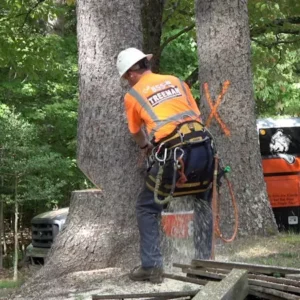Tree Removal Financing: A Comprehensive Guide
Tree removal can be a daunting task, both in terms of the physical work involved and the costs associated with it. Whether it’s a safety hazard, a disease-ridden tree, or simply for aesthetic reasons, removing a tree is often necessary. Yet, the financial side of things can be a major worry. This guide will walk you through everything you need to know about financing tree removal, ensuring you’re well-prepared to tackle this task without breaking the bank.

Understanding Tree Removal Costs
The cost of tree removal can vary widely, influenced by several factors. The size of the tree, its location, and the complexity of the removal all play crucial roles. Typically, the expense for removing a tree varies between $200 and $2,000. Additionally, there may be hidden costs such as stump grinding, debris removal, and permit fees. Understanding these costs upfront can help you plan your finances better.
Why Tree Removal Might Be Necessary
Taking down a tree can be required for a variety of reasons:
Safety Concerns: Overgrown or damaged trees can pose significant risks to your property and personal safety.
Disease and Pest Control: Infected trees can spread diseases or pests to other healthy trees.
Property Value and Aesthetics: Removing an unsightly tree can enhance the curb appeal and value of your property.
Financing Options for Tree Removal
When it comes to financing tree removal, several options are available:
Personal Savings: Using your savings can be the most straightforward way, avoiding any interest or fees.
Credit Cards: Though they offer convenience, credit cards frequently come with steep interest rates.
Personal Loans: These loans typically have lower interest rates compared to credit cards and fixed repayment terms.
Home Equity Loans: Leveraging your home equity can offer lower interest rates but involves using your home as collateral.
Financing Through Tree Removal Companies: Some tree removal services offer financing plans, allowing you to pay over time.
Pros and Cons of Each Financing Option
Every funding choice comes with its own set of advantages and disadvantages.
Personal Savings: No interest or fees, but depletes your emergency fund.
Credit Cards: Convenient but expensive due to high-interest rates.
Personal Loans: Lower interest rates, but require good credit scores.
Home Equity Loans: Lower rates, but your home is at risk if you default.
Financing Through Companies: Flexible plans but may come with higher overall costs.
How to Choose the Best Financing Option
Selecting the appropriate financing option relies on various factors.
Assessing Your Financial Situation: Determine how much you can afford to pay upfront and monthly.
Comparing Interest Rates: Look for the lowest rates to save on interest over time.
Understanding Repayment Terms: Ensure you can meet the repayment terms without straining your finances.
Finding Tree Removal Services That Offer Financing
To find tree removal services that offer financing:
Research Local Companies: Look for reputable companies in your area.
Read Reviews and Testimonials: Customer feedback can provide insights into the company’s reliability.
Ask About Financing Plans: Directly inquire about financing options and terms.
Steps to Apply for Tree Removal Financing
When applying for tree removal financing:

Prepare Your Financial Documents: Gather necessary documents such as income proof and credit reports.
Meet Eligibility Requirements: Ensure you meet the lender’s criteria.
Understand the Application Process: Follow the lender’s application steps carefully to avoid delays.
Tips for Managing Tree Removal Costs
To manage tree removal costs effectively:
Get Multiple Quotes: Compare prices from different services to find the best deal.
Schedule During Off-Peak Seasons: Prices may be lower during less busy times.
Negotiate Prices: Don’t hesitate to negotiate for better rates.
Insurance and Tree Removal
Understanding your homeowners insurance can save you money:
Homeowners Insurance Coverage: Some policies may cover tree removal if it’s due to an insured peril.
Filing Claims: Learn how to file a claim to get reimbursed.
When Insurance Doesn’t Cover Tree Removal: Understand the exclusions in your policy.
Environmental Considerations
Removing a tree responsibly involves:
Sustainable Tree Removal Practices: Ensure the company uses eco-friendly methods.
Replanting and Landscaping Options: Consider replanting to maintain the ecological balance.
Local Regulations and Permits: Check local laws and obtain necessary permits.
DIY Tree Removal vs. Professional Services.
While DIY removal might seem cost-effective:
Risks of DIY Removal: Lack of expertise can lead to injuries or property damage.
Benefits of Hiring Professionals: Professional services offer safety, efficiency, and proper equipment.
Cost Comparison: Weigh the potential savings against the risks involved.
Long-term Financial Planning for Tree Maintenance
Planning for future tree care can save you money:
Budgeting for Future Tree Care: Allocate funds for regular maintenance.
Setting Aside Emergency Funds: Prepare for unexpected tree issues.
Regular Maintenance to Prevent Costly Removals: Regular care can prevent expensive removals in the future.
Common Mistakes to Avoid When Financing Tree Removal
Avoid these pitfalls when financing tree removal:
Ignoring Hidden Fees: Be aware of all potential costs.
Overlooking Insurance Options: Check if your insurance covers any part of the removal.
Failing to Read the Fine Print: Understand all terms and conditions before signing.
Conclusion
Tree removal can be a significant expense, but with the right planning and financing options, it doesn’t have to be overwhelming. Assess your financial situation, explore your financing options, and choose the one that best fits your needs. By doing so, you can ensure a smooth and stress-free tree removal process.

